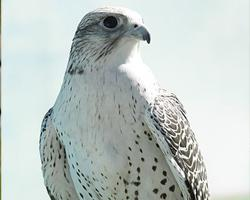
Poids et mesures
| Longueur | de 49 à 59 cm |
|---|---|
| Poids | 0,8 kg |
Description de l'animal
The Crested Caracara (Caracara plancus), also known as the Southern Caracara or Carancho, is a distinctive bird of prey that belongs to the family Falconidae, which includes falcons and caracaras. This species is unique for its diverse range of habitats and its opportunistic feeding behavior. Unlike many other raptors, the Crested Caracara is as comfortable walking on the ground as it is soaring in the skies.Physical Description
The Crested Caracara is a large bird, with adults typically measuring between 50 to 65 cm (19.7 to 25.6 inches) in length, and having a wingspan that ranges from 120 to 132 cm (47 to 52 inches). They weigh between 0.8 to 1.3 kg (1.8 to 2.9 lbs), with males generally being slightly smaller than females. One of the most striking features of this bird is its bold plumage. The body is predominantly black and dark brown, with a stark contrast provided by white at the base of the neck, on the tail, and in patches on the wings. The tail features a broad band of black near the end, which is a distinctive marker when the bird is in flight.
The head of the Crested Caracara is adorned with a small, black crest, which can be raised or lowered. The face is bare, showcasing a patch of reddish or yellowish skin, which can flush or intensify in color during social interactions or in response to stress. Its hooked beak is powerful, designed for tearing flesh, and is a bluish-gray color, tipped with black. The legs are long and strong, enabling it to walk and run efficiently on the ground, and are a striking yellow, matching the cere (the soft, fleshy swelling) at the base of the beak.
Habitat and Distribution
The Crested Caracara has a broad distribution, ranging from the southern United States through Central America, and down into South America as far as Tierra del Fuego. It is a versatile species, inhabiting a variety of open and semi-open landscapes including savannahs, grasslands, coastal regions, and agricultural lands, often avoiding dense forests. This bird is particularly adept at exploiting human-altered landscapes, and can often be found near roads and farms where it scavenges for carrion.
Behavior and Diet
Crested Caracaras are omnivorous and opportunistic feeders. Their diet is incredibly varied and includes carrion, small mammals, amphibians, reptiles, birds, insects, and occasionally fruit and palm nuts. They are known to follow plows in fields to catch insects and small animals turned up by the machinery. Unlike many raptors, Caracaras are not averse to scavenging and can often be seen feeding on roadkill alongside vultures.
These birds are both diurnal and highly territorial. They are usually seen singly or in pairs, and sometimes in family groups, especially during the breeding season. Their nests are large structures made of sticks, built in trees or on cliffs. Both parents are involved in raising the young, which emphasizes their social nature.
Vocalization and Communication
The Crested Caracara is less vocal than some birds of prey, but it does produce a variety of sounds, especially during the breeding season. Its calls include a repeated, shrill 'kree-kree-kree' and a lower 'ank-ank-ank'. These sounds play an important role in territorial displays and in maintaining pair bonds.
Conservation Status
Currently, the Crested Caracara is not considered globally threatened. It benefits from its wide range, large population, and adaptability to human-modified landscapes. However, in some areas, it faces threats from habitat destruction and persecution, as it is sometimes seen as a pest by farmers.
In conclusion, the Crested Caracara is a remarkable bird of prey, distinguished by its unique appearance, versatile feeding habits, and wide distribution. Its adaptability to different environments, including those altered by humans, has allowed it to thrive in a variety of settings, making it a fascinating subject of study for ornithologists and bird enthusiasts alike.
Animaux similaires
Nouvelles photos d'animaux
Top 10 des animaux
- Dolphin gull (Leucophaeus scoresbii)
- Diana monkey (Cercopithecus diana)
- Moustached guenon (Cercopithecus cephus)
- Galápagos tortoise (Geochelone nigra complex)
- Japanese macaque (Macaca fuscata)
- Stone loach (Barbatula barbatula)
- Russian tortoise (Testudo horsfieldii)
- Greek tortoise (Testudo graeca)
- Common flying dragon (Draco volans)
- Vendace (Coregonus albula)


